Journey to Space 4K + 3D Blu-ray Movie
HomeJourney to Space 4K + 3D Blu-ray Movie 
IMAX / 4K Ultra HD + Blu-ray 3D + Blu-rayShout Factory | 2015 | 42 min | Not rated | Jun 07, 2016
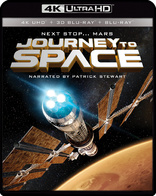
Movie rating
7.3 | / 10 |
Blu-ray rating
| Users | 0.0 | |
| Reviewer | 4.0 | |
| Overall | 4.0 |
Overview
Journey to Space 4K + 3D (2015)
Discover how NASA’s shuttle program has led to its exciting new era of space exploration. Learn about the important role of the International Space Station. Uncover what NASA and the space community are working on, and the challenges they face to carry out bold missions such as capturing asteroids and landing astronauts on Mars. Narrated by Sir Patrick Stewart.
Narrator: Patrick StewartDirector: Mark Krenzien
| Documentary | 100% |
Specifications
Video
Video codec: HEVC / H.265
Video resolution: 4K (2160p)
Aspect ratio: 1.78:1
Original aspect ratio: 1.43:1
Audio
English: Dolby Atmos
English: Dolby TrueHD 7.1 (48kHz, 24-bit)
French: DTS-HD Master Audio 5.1
Spanish: DTS-HD Master Audio 5.1
Subtitles
English SDH
Discs
Blu-ray Disc
Two-disc set (2 BDs)
4K Ultra HD
Blu-ray 3D
Packaging
Slipcover in original pressing
Playback
Region free
Review
Rating summary
| Movie | 3.5 | |
| Video | 4.5 | |
| Audio | 5.0 | |
| Extras | 1.0 | |
| Overall | 4.0 |
Journey to Space 4K + 3D Blu-ray Movie Review
Reviewed by Jeffrey Kauffman May 4, 2016Some curmudgeons may wonder whether there really should have been a question mark adorning the end of Journey to Space’s title, since the halcyon days of the United States space program seem to be behind us, at least when compared to the rush of the sixties and the Moon landing, and subsequent adventures with the space shuttle. I’m old enough to actually remember that 1969 journey to our nearest neighbor, and the excitement it engendered (as well as the occasional outré reaction, like the insistence that it was being faked from a television studio in New Jersey). Journey to Space wants to make the case that we’re at the dawn of a new age in space exploration, but with a structure that concentrates initially on what amounts to an epitaph for the shuttle program, its thesis seems wobbly at best.
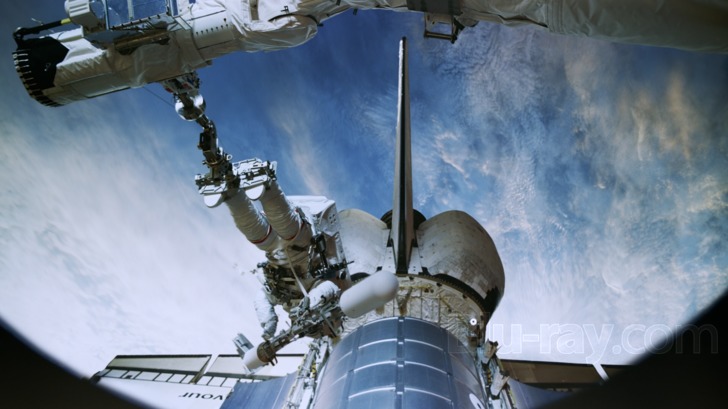
There’s a litany of several previous NASA and/or IMAX films credited in an opening text card before Journey to Space begins, an early sign that this brief “outing” has a rather cobbled together feeling. That only tends to add to a central question some may have while watching Journey to Space: what exactly is the point? It would seem to be a kind of cheerleading, “rah rah” documentary meant to hype interest in America’s space program, but if that’s so, why does an undue amount of this piece instead document a part of that program which is for all intents and purposes over and done with?
There’s certainly a lot of interesting and even inspiring information in this first part, however, though ironically some of the most compelling footage actually documents the delivery of the Endeavour to the California Science Center through an insane labyrinth of city streets, a feat of engineering that astronaut Chris Ferguson, who (despite the advertised presence of Patrick Stewart) narrates a long swath of the film, actually jokes looks at least as daunting as the engineering that actually got the Endeavour into space. But for a film which starts with an iconic quote from Carl Sagan about limitless possibilities and Man's propensity to "wander", then gives a very brief overview of some of Man’s early attempts at flight (imagine the prologue of Those Magnificent Men in Their Flying Machines or even the recently reviewed Master of the World trimmed down to just a few seconds), the long detour through space shuttle history may provoke stifled yawns in some, at least those who are yearning for skies yet unexplored.
The shuttle information is perhaps more understandable within the larger context of the International Space Station (the shuttle is after all described as a “delivery truck” of sorts for the ISS). There’s some appealing footage of the multinational forces who have manned (and womanned) the International Space Station, and the fact that some of them have spent many months in a weightless environment provides a natural segue of sorts to the section of Journey to Space that finally starts more of a forward thinking, “where will be headed next?” kind of approach.
In another break away from Patrick Stewart’s redolent tones, newish astronaut Serena Aunon takes over for another stretch, this time documenting her part in the “next generation” (sorry) of explorers who will hopefully be traveling to Mars one day. There’s some neat footage of the new Orion crew vehicle that’s being prepared for deep space exploration as well as some of the training regimens to operate it which are being developed. Interestingly, there are some deep space “vehicles” in planning stages that are inflatable balloons in a manner of speaking which resemble the big habitats that are part of The Martian, albeit not tethered to a planet. In fact lovers of the Matt Damon film will probably be geeking out on the prospects of a Mars landing which are documented in Journey to Space.
In a rather interesting marketing gambit, and one which I’m personally encountering for the first time in my reviewing career, Shout! Factory has decided to release Journey to Space in both a two disc version which includes both the 4K UHD iteration as well as a combo Blu- ray offering both 2D and 3D presentations in 1080p, as well as a standalone 1080p Blu-ray offering only the 2D version. Those without 3D televisions will obviously probably prefer the standalone version, but even those who haven’t yet adopted the new 4K UHD format may be drawn to the two disc release if they at least have a 3D television and Blu-ray player. That way they’re “future proofed” and will already have the 4K UHD version should they jump into the fray with this newfangled hardware. Future proofing is in a way one of the central lessons Journey to Space itself deals with, and it’s funny in a way this disc release should bring up tangential issues itself in somewhat the same regard.
Journey to Space 4K + 3D Blu-ray Movie, Video Quality 
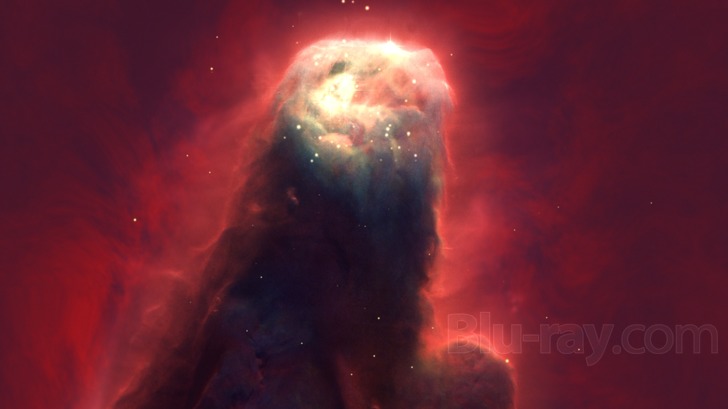
Note: The included screenshots are sourced from a 1080p Blu-ray disc. Watch for 4K screenshots at a later date.
This two disc version of Journey to Space contains a 4K UHD Blu-ray disc offering Journey to Space with an HEVC / H.265
encoded 2160p transfer in 1.78:1, and another standard Blu-ray disc offering AVC (2D) and MVC (3D) encoded 1080p transfers in 1.78:1. With
such a glut of choices, there's quite a bit to discuss in this assessment of the release's video quality in its various versions.
The 4K UHD version offers superior levels of detail and some almost awe inspiring gradations of celestial hues in elements like its
reproductions of images from the Hubble Telescope. (The 4K UHD disc offers an option to view the documentary with either HDR or SDR, again
the first time I've personally encountered this in my admittedly brief time reviewing 4K UHD discs.) As is discussed in the really well done if way
too brief Behind the Scenes featurette, Journey to Space was cobbled together from an almost insane number of different
formats, including everything from 65mm to newer digital capture to archival video from days of yore, and was scanned at up to 11K (and, no,
that's not a typo). With the wide array of source elements in mind, clarity, sharpness and grain
structure (when existent) are all highly variable, leading to a fairly heterogeneous look. The increased resolution tends to point out some of
the
flaws of the older footage especially, notably some brief black and white elements from some astronaut adventures on the moon. The
documentary "cheats" in a way by having a lot of the archival footage play out in what amounts to a "picture in picture" window within the
frame (see some of the screenshots accompanying this review for an example), something that aids in masking the disparity in clarity in
various source elements. Colors are often bold and vivid, and the CGI, while pretty rudimentary at times, is precise and sharp looking, albeit
minimally detailed. There was only one slight moment of quasi-judder or image instability that I noticed, during a brief tracking shot back from
a NASA crane, where the manufacturer's name shook very slightly. There was another very brief moment of shimmer on the solar panels of the
International Space Station, something that was more apparent in the 3D viewing experience than the 4K UHD.
The 3D version offers significant depth quite a bit of the time, but ironically some of that depth turns out to be the spatial difference between
the "picture in picture" window and the general background, rather than whatever is within the window itself. Still, from the first aerial shots
of beautiful landscapes, to some rotoscoped archival images of Man's early attempts at flight, to later animations of planets and planned
expeditions, there's quite a bit of depth within the frame, albeit rather subtly at times. Some of the best "protrusions" come from a slightly
animated approach toward the Hubble Telescope images, where the swirling clouds of stellar matter move slightly or individual elements have
been quasi-rotoscoped to float out toward the audience. As noted above, there are a couple of very brief moments of image instability,
including one of the solar panels on the International Space Station which was a bit more jittery in its 3D version than the 2D or 4K UHD.
The 2D version offers a commendably sharp and precise looking image, albeit one that (again) is fairly heterogeneous due to the wide
disparity in source elements utilized for the documentary. Aside from the aforementioned very brief anomalies with image instability, there's
little to complain about here (and in fact the judder on the tracking shot over the crane is negligible in the 1080p version in either its 2D or 3D
iterations).
Note: I found it a little humorous that this first Shout! 4K UHD disc is one of the few I've reviewed where I had absolutely no HDMI
handshake issues. Take that, Fox, Sony and Lionsgate!
Journey to Space 4K + 3D Blu-ray Movie, Audio Quality 
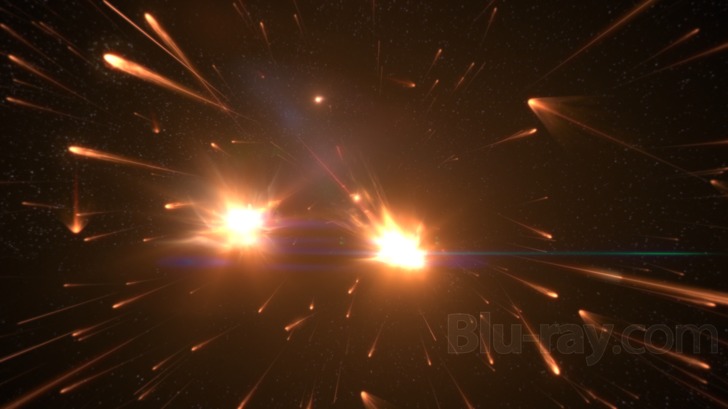
Journey to Space features an absolutely overpowering Dolby Atmos mix which will have both your floorboards and your ceiling
boards (if such things exist) rattling during a couple of launch sequences featuring space shuttles. The Atmos speakers provide a wash of
overhead activity as the shuttle rises from the launchpad, and there's an almost vibrational essence pulsating through the air that can virtually
be felt. Some great attention to detail is also lavished on discrete channel placement for effects. One notable moment comes during a landing of
the shuttle where there's a clear rattling sound emanating from the rear right channel that had me thinking, "You know, someone really ought to
look into that." The documentary has the typical overamped score that is often a part of such outings (including some needless quotes from
Holst's The Planets), and there were a few times where I felt the music was competing with the sonorous tones of Patrick Stewart, but
never to the point that I couldn't hear the narration. Fidelity is superb and dynamic range incredibly wide on this awesome sounding track.
A reminder for those who want to watch the 3D version on their PS3: due to the longstanding issues with this player, the Dolby Atmos (or core
Dolby TrueHD 7.1) track won't engage (sorry again), and instead the film will default to a Dolby Digital 5.1 track, which is really a shame—the
difference in low end and general amplitude is immediately noticeable.
Journey to Space 4K + 3D Blu-ray Movie, Special Features and Extras 

4K UHD Supplements
- Behind the Scenes (2160p; 5:03)
- Gallery (2160p; 1:30)
- Behind the Scenes (1080p; 5:03)
- Gallery (1080p; 1:30)
Journey to Space 4K + 3D Blu-ray Movie, Overall Score and Recommendation 
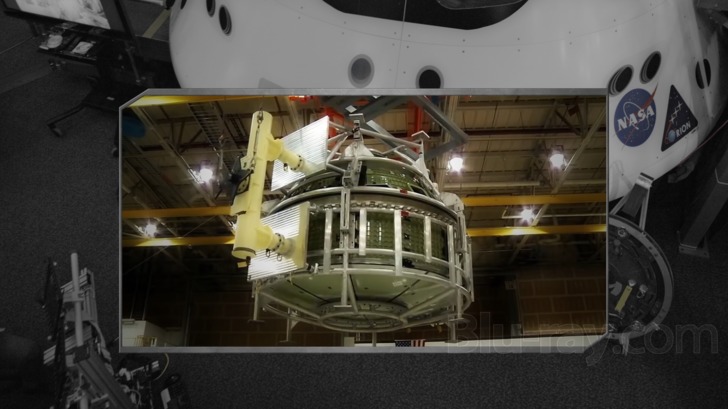
Journey to Space may not in fact go where no one has gone before, and arguably spends too much time on where we've already been, but it provides a glut of fascinating imagery (both earthbound and stellar) as well as offering a generalist overview of where our space program (such as it is) is at the current time. The documentary never proves to be quite as exhilarating or consistently inspirational as I would have hoped, but its technical merits are top notch. This interesting marketing gambit by Shout! which includes both a 4K UHD disc and a combo 2D/3D "standard" 1080p Blu-ray disc deserves credit, and early adopters will find plenty to amaze themselves (and their friends and relatives) with here since the technical merits are so outstanding. Highly recommended.
Similar titles
Similar titles you might also like

The Last Reef: Cities Beneath the Sea 4K + 3D
2012

Humpback Whales 4K + 3D
IMAX
2015

Wonders of the Arctic 4K + 3D
IMAX
2014

Flight of the Butterflies 4K + 3D
IMAX
2012

Rocky Mountain Express 4K
IMAX
2011

IMAX: Hubble 3D
2010

National Parks Adventure 4K + 3D
2016

IMAX: Dream Big: Engineering Our World 4K + 3D
2017

Space Station 3D
IMAX
2002

The Universe: The Complete Season Seven
Ancient Mysteries Solved
2013

Journey to the South Pacific 4K
IMAX Enhanced
2013

A Beautiful Planet 4K
IMAX Enhanced
2016

Sharks 3D
2004

Planet Earth II 4K
2016

James Cameron's Deepsea Challenge 3D
2014

Hidden Universe 4K
2013

Cosmos: A Spacetime Odyssey
2014

Blue Planet II 4K
2017

A Perfect Planet 4K
2021

Seven Worlds, One Planet 4K
2019
